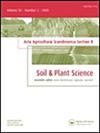Seed priming with selenite enhances germination and seedling growth of Sorghum [Sorghum bicolor (L.) Moench] under salt stress
IF 1.8
4区 农林科学
Q2 AGRONOMY
Acta Agriculturae Scandinavica Section B-Soil and Plant Science
Pub Date : 2023-02-24
DOI:10.1080/09064710.2023.2177561
引用次数: 1
Abstract
ABSTRACT Justify that the use of selenium has been shown to promote seed germination and seedling growth of some crops under salt stress but the physiological mechanisms in sorghum remain poorly understood. Herein, grain sorghum [Sorghum bicolor (L.) Moench] variety Jinza 2002 was used to explore the effects and mechanisms of seed priming with 25 μmol/L sodium selenite [Se(IV)] on seed germination, seedling growth, antioxidant enzyme activity and osmotic regulatory substances under 120 mmol/L NaCl. The results showed that soaking sorghum seeds in Se(IV) effectively alleviated the harm of salt stress. Compared with the Na group, Se(IV) application increased germination percentage (by 23.8%), while facilitating the elongation of radicles (by 4.2%) and plumules (by 18.4%) under salt stress. Salt-stressed seedlings showed increased levels of leaf chlorophyll, soluble sugar, soluble protein and proline contents, and antioxidant enzyme activities, as well as root activity, and total biomass following Se(IV) application, along with decreased relative electrical conductivity and malondialdehyde content in the leaves. Findings of this study indicate that seed priming with Se(IV) facilitates sorghum seed germination and seedling growth under salt stress by improving root activity, enhancing leaf photosynthesis and antioxidant responses, and reducing cell membrane damage.亚硒酸盐对高粱种子萌发和幼苗生长的促进作用在盐胁迫下
本文章由计算机程序翻译,如有差异,请以英文原文为准。
求助全文
约1分钟内获得全文
求助全文
来源期刊
CiteScore
4.40
自引率
0.00%
发文量
56
审稿时长
2.3 months
期刊介绍:
Acta Agriculturæ Scandinavica Section B publishes original research in applied soil and plant science with special attention given to to crop production in agri- and horticultural systems. We welcome manuscripts dealing with:
Climate smart and sustainable crop production systems
Water and nutrient efficiency
Soil conservation and productivity
Precise agriculture systems
Applications of bio- and nanotechnology
Digitalisation and robotics
Soil-plant interactions
Acta Agriculturæ Scandinavica, Section B – Soil & Plant Science forms part of a series of titles published on behalf of the Nordic Association of Agricultural Science (NJF). The series also includes Section A - Animal Science .

 求助内容:
求助内容: 应助结果提醒方式:
应助结果提醒方式:


